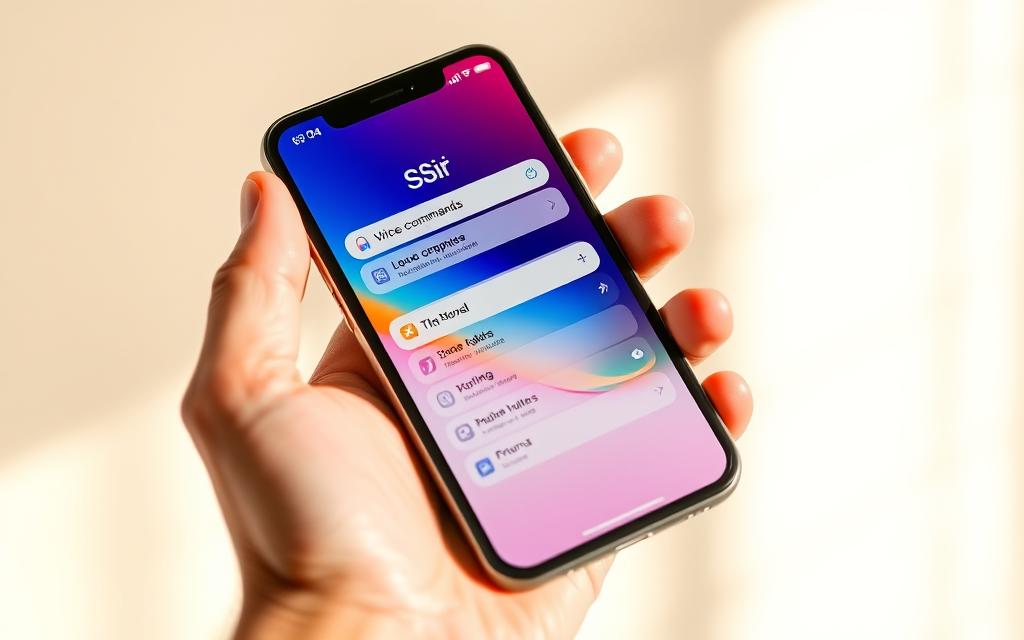Local Business Voice Search Optimization Guide
Are you having trouble getting your local business seen online? You’re not alone. More people are using voice search with Siri, Google Assistant, and Alexa. But are you ready for local business voice search optimization?
Are you losing customers because you don’t use voice search optimization? By making your site voice search friendly, you can get more people to visit. We’ll show you why voice search is key and how to start a voice search strategy for your business.
Local Business Voice Search Takeaways
- Improve online visibility with voice search optimization
- Drive more foot traffic to your store
- Enhance your brand reputation
- Get started with a voice search strategy
- Stay ahead of the competition
Why Local Business Voice Search Optimization Matters
Voice search is changing how we find local businesses. It’s now key for businesses to optimize for voice search. More people use voice assistants to find what they need nearby.
The Rise of Voice Search
Voice search is growing fast. Smart speakers and devices make it easy to search by voice. This means local businesses must adapt quickly.
Key statistics highlighting the rise of voice search include:
- A big jump in voice search queries recently.
- More people are using smart speakers and voice assistants.
- Searches are becoming more like conversations.
Impact on Consumer Behavior
Voice search changes how we search online. People now use natural language when searching. This affects local businesses a lot.
The main effects on consumer behavior include:
- Searches are more specific and detailed.
- People rely more on voice search for local info.
- They want quick, direct answers from businesses.
To stay ahead, local businesses must optimize for voice search. They need to be easy to find when people use voice commands.
To improve local business visibility in voice search, consider the following strategies:
- Make your website and online listings friendly for natural language.
- Keep your business info up-to-date everywhere online.
- Use schema markup to give search engines detailed business info.
Understanding How Voice Search Works
To make your local business better for voice search, you need to know how it works. Voice search uses natural language processing (NLP) and artificial intelligence (AI). These help understand voice commands and give good results.
Voice search tech has gotten much better. Now, it can do searches that feel more like talking to a friend. It works by understanding human language, like how we say things and what we mean.
Natural Language Processing and AI
NLP is a part of AI that lets computers get human language. For voice search, NLP helps devices get what we’re saying. AI makes it even better by learning from us and getting smarter over time.
Using NLP and AI in voice search has many good points. It makes searches more accurate and friendly. It also makes sure the results are what we really want.
Voice Search vs. Traditional Search
Voice search is very different from typing on a computer. Voice search uses whole sentences or questions. This means businesses need to change how they use SEO for voice search.
For example, to get better at voice search, you should:
- Use long-tail keywords that sound like how we talk
- Make content that answers questions clearly and fast
- Make sure your website works well on phones and loads fast

Key Differences Between Voice and Text Searches
The rise of voice search changes how local businesses optimize. Voice searches are more like talking. They use longer phrases or sentences.
Short Phrases vs. Full Sentences
Text searches are short and to the point. But voice searches are longer and sound like real talk. For example, “best Italian restaurants” is a text search. But “What are the best Italian restaurants near me?” is a voice search.
To optimize for voice search, local businesses should focus on long-tail keywords. This means using words that sound like how people talk. It’s about knowing what your customers ask when they search for what you offer.
Conversational Queries
Voice searches are like asking questions or making statements. People might say, “Where is the nearest coffee shop?” or “How do I get to the nearest bank?” Businesses need to think about how customers ask about their products or services.
By tailoring your content to match these conversational queries, you can show up in voice search results. Make content that answers common questions or solves problems your customers have.
To really get good at voice search, understand how people talk and ask questions. This way, local businesses can get more seen in voice search. It helps bring in more customers and sales.
Best Practices for Local Business Voice Search Optimization
Optimizing your local business for voice search can really help. It makes your online presence stronger and brings in more customers. To do this, focus on strategies that boost your voice search rankings.
One important strategy is to optimize for featured snippets. Featured snippets are short summaries at the top of Google’s search results. They give quick answers to users’ questions. To get featured snippets, make your content clear and direct. Answer common questions about your business. Use header tags to structure your content.
- Use a clear and concise format for your content
- Provide direct answers to common questions related to your business
- Structure your content using header tags (H1, H2, H3, etc.)
Another key point is the use of local keywords. Adding local keywords to your content helps search engines find your business. Use keywords like your city, state, or region in your website’s content and tags.
To improve your local business’s voice search, check out this table. It shows important strategies and their benefits:
| Strategy | Benefit |
|---|---|
| Optimize for Featured Snippets | Increases visibility in search results |
| Use Local Keywords | Improves relevance to local search queries |
| Create Conversational Content | Enhances user engagement and experience |

By using these strategies, you can improve your local business’s ranking in voice search. This will attract more customers. The main thing is to make high-quality, conversational content that voice search users will find helpful.
Creating a Voice-Friendly Website
To do well in voice search, your website needs to be made for how people speak, not just type. A website that works well for voice is very important for local businesses. It affects how users feel and how well your site shows up in searches.
Mobile Responsiveness is very important for a voice-friendly website. Most voice searches happen on phones. A site that works well on all devices makes it easy for users. It also helps your site show up better in searches.
Some key things for mobile responsiveness include:
- Flexible grids and layouts that adapt to different screen sizes
- Images that scale appropriately
- Easy-to-use navigation and clear typography
Fast Loading Times are also very important. A slow site can scare off users and hurt your search rankings. Voice search users want quick answers. A fast site gives them what they need fast.
To get fast loading times, think about:
- Optimizing images and compressing files
- Leveraging browser caching and content delivery networks (CDNs)
- Minimizing HTTP requests and streamlining code
By focusing on mobile responsiveness and fast loading, you can make a website that works well for voice. This improves user experience and helps your site rank better in voice searches.
Crafting FAQs for Voice Search
Creating FAQs for voice search helps your local business get noticed. It gives quick answers to users’ questions. Voice search users want short and direct answers.
Addressing Common Customer Questions
To make good FAQs, find out what customers often ask. Know your audience and what they need. Look at customer feedback, reviews, and your website or social media.
Tips for Identifying Common Questions:
- Look at customer feedback and reviews for patterns.
- Check your website’s search data for what users want.
- Use social media to see what customers are worried about.
Using Conversational Language
Voice search uses a conversational tone. So, your FAQs should be friendly and easy to read. Write like you talk.
For example, instead of “What are your business hours?”, users might say “What time do you open today?” or “Are you open on Sundays?” Your FAQs should answer these questions naturally and helpfully.
Here’s how to structure your FAQs for common questions in a conversational way:
| Question Type | Example Question | FAQ Answer |
|---|---|---|
| Business Hours | What are your hours today? | We’re open from 9 AM to 7 PM, Monday through Saturday, and 10 AM to 6 PM on Sundays. |
| Services Offered | Do you offer [specific service]? | Yes, we offer [specific service] as part of our [package/program]. |
| Contact Information | How can I contact you? | You can reach us by phone at [phone number], by email at [email address], or through our website’s contact form. |
By following these tips, you can make your local business more visible. You’ll also improve user experience and stay competitive.
Importance of Google My Business
A good Google My Business listing is key for local businesses. It helps them show up in voice search results. By optimizing their listing, businesses can get more seen in local searches.
Claiming and Optimizing Your Listing
To start, claim your Google My Business listing. You must verify your business and keep your listing current. Accurate categories, hours, and contact info help customers find you. Adding the right keywords and images also helps.
Keep your listing fresh with new content and quick customer review replies. Make sure your business’s name, address, and phone number (NAP) match everywhere online.
Encouraging Customer Reviews
Customer reviews are key for voice search. Good reviews make your business look better and help it show up in voice searches. To get more reviews, put review links on your website and social media.
- Always reply to reviews, good or bad, to show you care.
- Use review management tools to make responding easier and faster.
- Give happy customers a reason to review, like discounts or free stuff.
By working on Google My Business and reviews, you can boost your local business’s voice search. This can bring more customers and more money to your business.
Measuring Your Voice Search Performance
It’s key for local businesses to know how to check their voice search performance. This helps them stay ahead in the digital world. You need the right tools and analytics to see how well your voice search optimization is doing.
Tools for Tracking and Analytics
Many tools can help you track and analyze your voice search performance. Google Search Console is a must-have. It shows how your site looks in search results, including voice searches. It helps you see which keywords bring traffic and where you can get better.
Google Analytics is also great. It shows how people act on your site. Ahrefs or SEMrush are good for SEO audits and tracking keywords too.
| Tool | Functionality | Benefit for Voice Search |
|---|---|---|
| Google Search Console | Monitors search results performance | Insights into voice search queries |
| Google Analytics | Analyzes user behavior | Understanding voice search-driven traffic |
| Ahrefs/SEMrush | SEO audits and keyword tracking | Optimizing content for voice search keywords |
Analyzing User Engagement
It’s important to check how users interact with your content. Look at average session duration, bounce rate, and pages per session. These metrics tell you a lot about user behavior.
By looking at these numbers, you can make your voice search better. For example, if many people leave quickly, your content might not match what they’re looking for. You can then change your strategy to better meet their needs.

- Keep your content fresh and relevant to what users are searching for.
- Use natural language and long-tail keywords to match voice search better.
- Make sure your website works well on mobile devices, as many voice searches happen on phones.
By using these strategies and the right tools, you can improve your voice search. This will bring more people to your local business.
Future Trends in Voice Search
Voice search is changing fast. It’s key for businesses to keep up. New tech will change how we talk to customers. You need to update your voice search plan.
Advancements in Voice Assistants
Voice assistants are getting smarter. They understand us better with AI and natural language. You can make your local business more visible by using conversational searches and specific keywords.
To use voice search well, make your site mobile-friendly and easy for voice search. This helps you reach more customers and stay ahead.
Innovations in Local Business Marketing
New trends in voice search are exciting. They will change local marketing. Keep up with voice search news and update your strategy to stay ahead.
By getting ready for these changes, you can make your business more visible. This will attract more customers to you.



